ASUS UL50Vt Preview: Factory Overclocked CULV Delivers 7 Hours of Battery Life
by Anand Shimpi & Laura Johnston on September 14, 2009 12:00 AM EST- Posted in
- Laptops
The ASUS UL50Vt: Overclocked CULV
I’m going to preface this next section with an apology. I spent most of last week meeting with AMD about its next-gen GPU (part of the time on an aircraft carrier rented out by AMD to demonstrate the, uh, awesomeness of its new GPU). I ended up only having around two days with the ASUS notebook before this preview had to go live. We’ll have more detailed coverage in the future, but please accept my apologies as this is a very brief preview.

More about what I did on the USS Hornet next week
This is the ASUS UL50Vt, it’s a 15.6” notebook with a 1366 x 768 display.

The 50V is the largest in the UL series, there will also be a 13.3” and a 14” model that are more fitting of the CULV CPU.

The chip used in the UL50Vt is an Intel Core 2 Duo SU7300. A 45nm Penryn derivative the SU7300 has a 3MB L3 cache and runs at 1.3GHz, blech. It’s like a really slow Core 2 Duo E7200. But ASUS does have an ace up its sleeve: Turbo33.
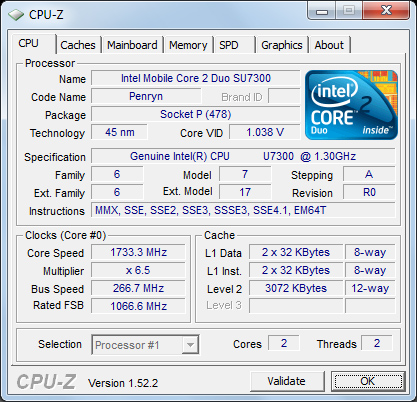
1.73GHz and still lower voltage than most Core 2 Duos
The 33 stands for percent, as in the percent increase in CPU frequency when running in Turbo33 mode. The 1.3GHz SU7300 runs at 200MHz x 6.5 but in Turbo33 mode the FSB gets bumped up to 266MHz and the chip runs at 1.73GHz (266MHz x 6.5).
The performance difference is noticeable, it takes the CULV from slow to an acceptable level of performance. All of the ULxxt notebooks will ship with Turbo33.
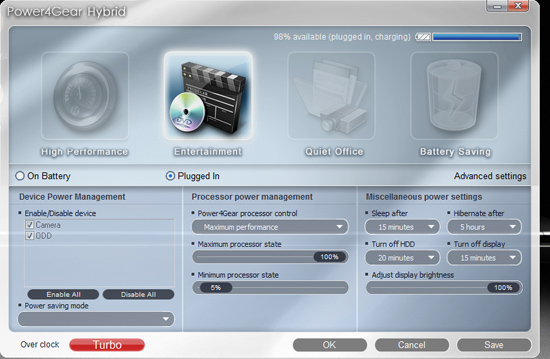
Turbo33 is controlled through ASUS’ PowerGear4 utility. By default the systems ships with it on; very cool.
But what about the impact on battery life? Overclocking is generally frowned upon in notebooks since it, you know, draws more power.
Thankfully the CULV chips start at a lower than normal voltage already, so when overclocked (even while overvolted) they still end up at a reasonable voltage level.
The UL50Vt has a big honking 84Wh battery thanks to the width of the system. The UL30Vt and UL80Vt (13.3” and 14” models) will also have an 84Wh battery, although some models may come with a 63Wh battery.

I only had the UL50Vt for a couple of days so I didn’t have much opportunity to do anything with the system other than use it and run a few numbers. The relevant details are below:
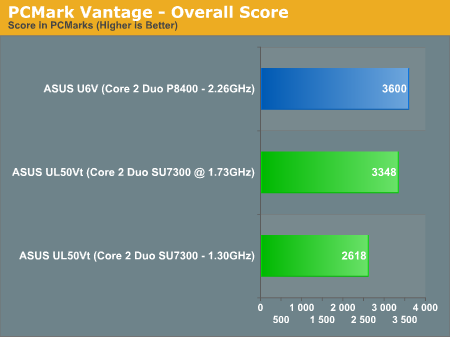
ASUS estimates that with the Intel integrated graphics active the UL50V can last for up to 12 hours. I ran our heavy Flash web browsing test and came up with just under 7 hours of battery life on the UL50V.
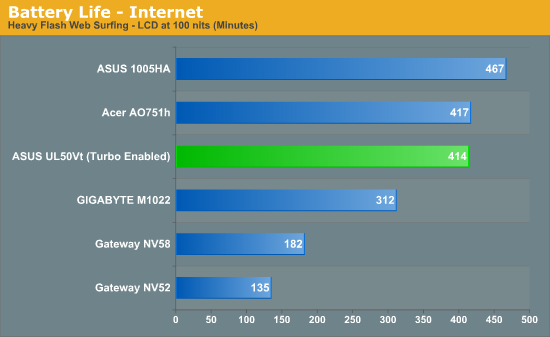
Netbook battery life, but notebook performance
This sort of battery life from an overclocked CULV is impressive. With the same sized battery in the smaller models, I’d expect the same sort of battery life out of them.

The UL50Vt also ships with a GeForce G210M as its discrete GPU. Much faster (and power hungry) than the integrated graphics, ASUS estimates that it’ll knock off about an hour off the battery life. I didn’t get the chance to drain the battery using the G210M but leave your comments below and we’ll address everything you’d like in a full review of the platform.
The notebook looks and feels pretty good. ASUS went with an aluminum top to at least distract you from the plastic elsewhere.

The keyboard looks like Apple’s chiclet keyboard, but the feel is unfortunately not as nice. The tactile response just isn’t as solid as on the Apple.

I’d also take this opportunity to talk about the textured trackpad on the UL50Vt. I’ve seen this used before and while it’s different, I don’t believe it’s ideal. Personally, I’d prefer my trackpad to be as smooth as possible.
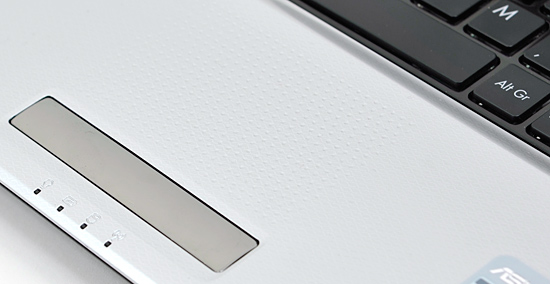
The 1366 x 768 resolution is definitely too low for the 15.6” model in my opinion, but it should be fine on the smaller models. Weight is around 2.1 kg (4.63 lbs); the 13” UL30Vt should be under 3 lbs.
The 15.6” UL50Vt and the 13.3” UL30Vt will retail for $849 once they start shipping at the end of this month. I don’t have full specs on the UL30Vt but this is how the UL50Vt will be configured:

The battery life is the most attractive thing about the UL50Vt, at nearly 7 hours of web browsing (and more if you’re just writing) I can’t complain. Again, the more interesting models will be the 13.3" and 14" CULV systems since they'll actually exploit the portability offered by the processor.
ASUS’ take on CULV is very interesting and I will say that as long as battery life stays high, I don’t care if it takes overclocking to get there.










51 Comments
View All Comments
MrSpadge - Monday, September 14, 2009 - link
I've got one of the first Penryns in my notebook and it gets by happily with the minimum voltage the board can supply (0.925 V) up to 2.0 GHz. I'd be surprised if this chip needed any more than this even at 1.73 GHz.MrS
araczynski - Monday, September 14, 2009 - link
this is intel's way of trying to con people into buying overpriced hardware again.at this price point, unit size, you'd have to be close to retarded to buy a neutered laptop.
you'll want either a cheap/small netbook, or something with some balls.
this thing is stuck in the WTF middle, not cheap, not small, and still weak.
MrSpadge - Monday, September 14, 2009 - link
It's not Intel who choose to put this CPU into a 15" chassis.MrS
JohnMD1022 - Monday, September 14, 2009 - link
$850? lololol... I'll passirev210 - Monday, September 14, 2009 - link
When you go to the 11.6" form factor, the higher resolution screen and the similar weight, battery life, and cost of a typical netbook makes the CULV a no-brainer.I am surprised more notebook manufactures haven't attacked the 11.6" market. The Acer AS1410 is really the only compelling 11.6" product on the market at the moment.
$437 shipped from amazon... where is ASUS, Lenovo, Samsung, etc?
I think a 11.6" formfactor + CULV is what the people want, they just don't know it yet.
Fanfoot - Monday, September 14, 2009 - link
I assume most of the readers who come here are performance geeks and don't care about anything that isn't the fastest and best...I'd encourage you to ignore them and cover stuff that is important regardless. Personally I'm interested in the CULV laptop space (and maybe even the CULV internet streamer little box beside the TV space). And this article is therefore quite interesting to me.
Atom netbooks are GREAT and ground breaking, but yes they're slower than we'd like. It seems likely that CULV mini laptops will be more expensive, but if its only a little it MIGHT be worth it given that the battery life won't be that different. So to me something like an 11" thin-n-light makes the most sense.
The main thing I'd like to see you cover is whether you can handle HD Flash full screen on a 720p laptop screen using a CULV processor (and whatever GPU) at the moment, or not? Given that even a dual core Atom 330 with Ion can't do this, even when you overclocked it to 2.0GHz, this would be a significant improvement.
MadMan007 - Thursday, September 17, 2009 - link
There are proper reviews out you just need to search around a bit. Here's one: http://www.techreport.com/articles.x/17435/6">http://www.techreport.com/articles.x/17435/6 from the 'YouTube HD windiwed' results I think we can extrapolate that a full screen video would run ok but you'll need a dual core CULV to do so.fitten - Tuesday, September 15, 2009 - link
Indeed... these CULV processors might be pretty nice for HTPC boxes as well...strikeback03 - Monday, September 14, 2009 - link
AMD must really be hoping for good profits on these GPUs to go to the expense of renting an aircraft carrier.Guspaz - Monday, September 14, 2009 - link
Nice to have the G210M in there. It actually only uses slightly more power (14W) than the 9400M used in the Ion (12W), although I'm not sure if that 12W includes the rest of the ION chipset.Performance-wise, it looks like it should be a third to half again faster than the 9400M. Having this is nice, because you can disable it when you're on battery, and enable it when you're on AC power.
It's unfortunate that the notebook doesn't use an nVidia chipset with a 9400M; the G210M supports Hybrid-SLI (SLI between the integrated (9400M) and discrete (G210M) GPUs) which would really let you push some decent performance when on AC power.